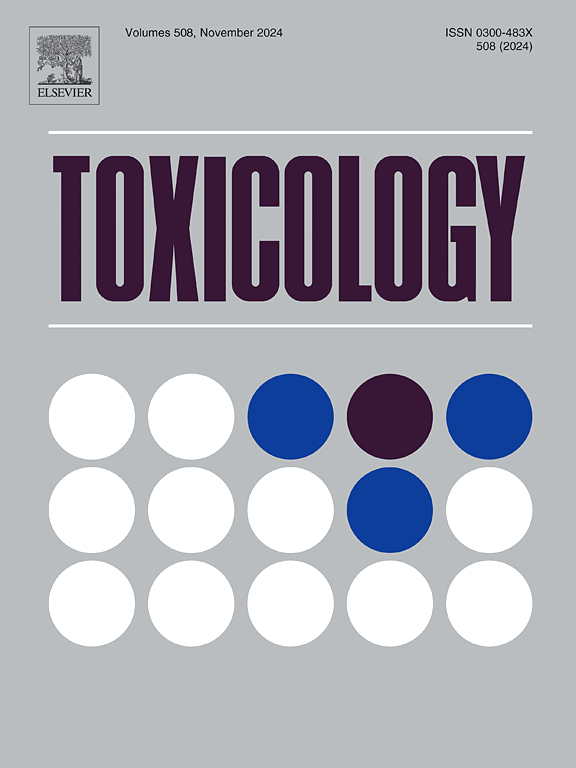间质细胞和支持细胞对双酚A敏感性的差异
IF 4.6
3区 医学
Q1 PHARMACOLOGY & PHARMACY
引用次数: 0
摘要
双酚A (BPA)是一种干扰内分泌的化学物质,由于其无处不在和毒性,它正日益成为影响公众健康的重要因素。BPA通过破坏睾丸间质和支持细胞的功能与男性不育有关。尽管进行了广泛的研究,但目前对BPA暴露后的具体病理浓度和机制的理解仍然存在疑问。因此,我们研究了不同BPA剂量(0.0001-100 µM, 10倍连续稀释)对Leydig和Sertoli细胞的敏感性及其潜在机制。结果表明,最低BPA浓度(10−4 μM)降低了线粒体膜电位和ATP水平。相比之下,在两种细胞类型中,无论暴露时间(24或48 h)如何,高BPA水平下ROS水平均增加。线粒体介导的细胞凋亡伴随着ROS水平升高和线粒体动力学异常,但两种细胞类型对BPA毒性的易感性不同。随后,BPA对间质细胞中甾体生成酶mRNA表达水平和睾酮合成产生不利影响,并减少了Sertoli细胞中的锚定连接蛋白。因此,我们的结果表明,这两种细胞都受到雌激素受体α的影响。然而,蛋白激酶A在BPA暴露后在每种细胞类型中表达相反。因此,有理由认为每个细胞对BPA的反应都有不同的敏感性和机制。本文章由计算机程序翻译,如有差异,请以英文原文为准。
Differential susceptibility of Leydig and Sertoli cells to bisphenol A
Bisphenol A (BPA) is an endocrine-disrupting chemical that is increasingly becoming a vital factor in public health due to its ubiquity and toxicity. BPA is associated with male infertility via the disrupted function of Leydig and Sertoli cells. Despite extensive research, the current understanding of the specific pathological concentrations and the mechanisms following BPA exposure still remain questionable. Therefore, we investigated the susceptibilities and underlying mechanisms in Leydig and Sertoli cells following treatment with various BPA doses (0.0001–100 µM in a 10-fold serial dilution). Our results showed that the lowest BPA levels (10−4 μM) decreased mitochondrial membrane potential and ATP levels. In contrast, ROS levels were increased at high BPA levels regardless of exposure time (24 or 48 h) in both cell types. Mitochondrial-mediated apoptosis was identified along with increased ROS levels and abnormal mitochondrial dynamics, but both cell types showed different susceptibility to BPA toxicity. Subsequently, BPA had detrimental impacts on the mRNA expression levels of steroidogenic enzymes and testosterone synthesis in Leydig cells and reduced anchoring junction proteins in Sertoli cells. Consequently, our results demonstrated that both cells were affected via estrogen receptor alpha. However, protein kinase A was oppositely expressed following BPA exposure in each cell type. Therefore, it is plausible to suggest that each cell has distinct sensitivities and mechanisms in response to BPA.
求助全文
通过发布文献求助,成功后即可免费获取论文全文。
去求助
来源期刊

Toxicology
医学-毒理学
CiteScore
7.80
自引率
4.40%
发文量
222
审稿时长
23 days
期刊介绍:
Toxicology is an international, peer-reviewed journal that publishes only the highest quality original scientific research and critical reviews describing hypothesis-based investigations into mechanisms of toxicity associated with exposures to xenobiotic chemicals, particularly as it relates to human health. In this respect "mechanisms" is defined on both the macro (e.g. physiological, biological, kinetic, species, sex, etc.) and molecular (genomic, transcriptomic, metabolic, etc.) scale. Emphasis is placed on findings that identify novel hazards and that can be extrapolated to exposures and mechanisms that are relevant to estimating human risk. Toxicology also publishes brief communications, personal commentaries and opinion articles, as well as concise expert reviews on contemporary topics. All research and review articles published in Toxicology are subject to rigorous peer review. Authors are asked to contact the Editor-in-Chief prior to submitting review articles or commentaries for consideration for publication in Toxicology.
 求助内容:
求助内容: 应助结果提醒方式:
应助结果提醒方式:


